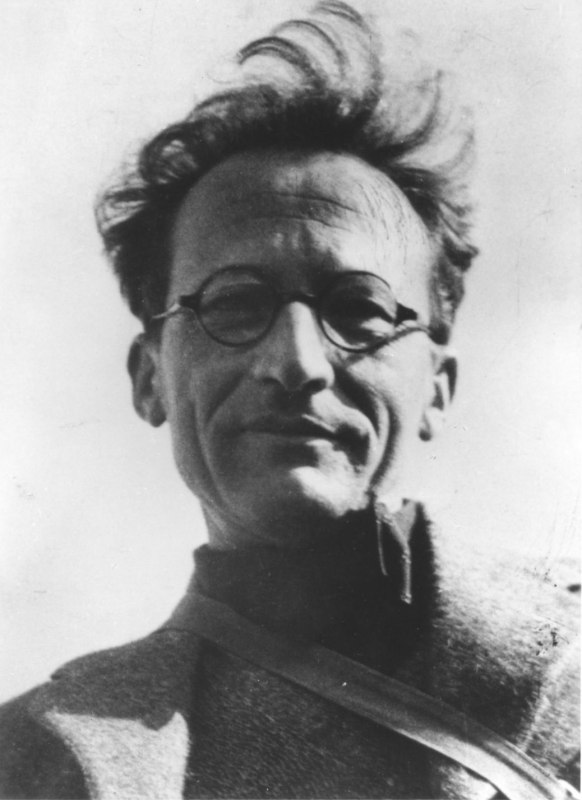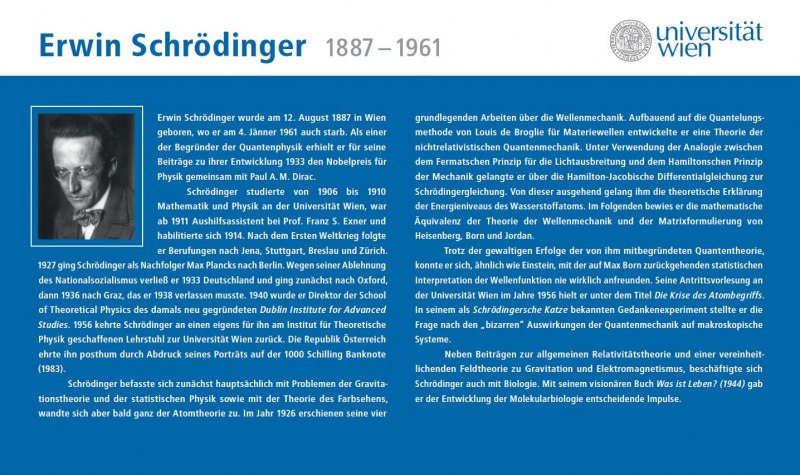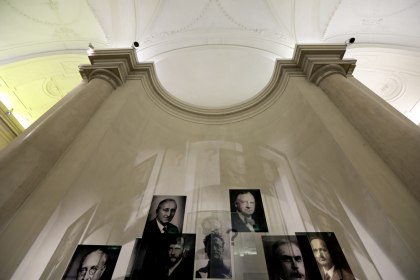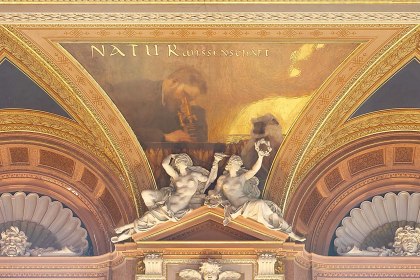Erwin Schrödinger, Prof. Dr.
Founder of wave mechanics ("Schrödinger equation")
Honors
| Ehrung | Titel | Datierung | Fakultät | |
|---|---|---|---|---|
| Monument in arcaded court | 1984 | Faculty of Natural Sciences |
|
|
| Monument "Nobel Prize and University of Vienna" | 2005/06 |
|
||
| Room Name | Erwin-Schrödinger-Hörsaal | 2009 | Faculty of Physics |
|
- Physics
- Theoretical Physics
- Faculty of Philosophy
Schrödinger, the son of a textile manufacturer and hobby botanist, attended secondary school in Vienna and then studied mathematics and physics at the University of Vienna. Among his teachers were Wilhelm Wirtinger and Franz Exner, as well as the theoretical physicist Fritz Hasenöhrl. Schrödinger obtained his doctorate under Hasenöhrl’s supervision in 1910 with the paper “Über die Leitung der Elektrizität auf der Oberfläche von Isolatoren an feuchter Luft”. Following this he worked at the 2nd Physical Institute as Exner’s assistant and habilitated in 1914 with the paper “Studien über Kinetik der Dielektrika, den Schmelzpunkt. Pyro- und Piezoelektrizität”. He took part in the First World War as an officer (senior lieutenant of the reserve) of the fortification artillery from 1914 until 1918.
After 1918, Schrödinger worked in Jena, became an associate professor at the Technical University of Stuttgart in 1920 and a full professor at the University of Breslau one year later. In that same year he took up the chair for physics at the University of Zurich, which formerly had been held by Albert Einstein and Max von Laue. During his time in Zurich he formulated the “Schrödinger-equation”, which is named after him. Six years later he succeeded Max Planck as professor for theoretical physics at the University of Berlin. He held this position until the National Socialists’ rise to power in 1933, when he resigned out of protest and emigrated to England. Here he joined the Magdalen College Oxford. In that same year he was awarded the Nobel Prize for the discovery of wave mechanics together with Paul Dirac from the University of Cambridge.
In 1936 Schrödinger returned to Vienna and took up a professorship at the University of Graz. At the same time he also worked as an honorary professor at the University of Vienna and held lectures on theoretical physics until Austria’s “Anschluss” to the German Reich in 1938 again forced him to flee. The ministry of education revoked his honorary professorship at the University of Vienna on April 22nd, 1938, while the Reichsstatthalterei (Reich deputy’s office) at the end of August decreed his dismissal from his position as professor in Graz. A little earlier, on March 31st, the “Tagespost” in Graz had published a - possibly forced - statement by Schrödinger, in which he declared himself one of the people who had “until recently misjudged the true will and the true destiny of my homeland”. In regard to the “referendum” he writes that “every ‘no’ at the ballot box equals a national suicide”.
Schrödinger fled to Belgium in September 1938 and took up a visiting professorship at the University of Geneva. In 1939 he was called to the newly founded Institute for Advanced Studies in Dublin by the Irish prime minister at that time, Éamon de Valera.
After the end of the war, Schrödinger in principle wanted to return to the University of Vienna. This, however, did not come about - not least, because he was afraid he, as a prominent natural scientist, might be kidnapped by the Soviets. Schrödinger remained in Dublin until receiving emeritus status in 1956. He did, however, teach at the University of Innsbruck as a visiting professor in 1950/51. In 1956 he finally permanently returned to Austria and the University of Vienna, when he became an associate professor for physics - a position which was created specifically for him on January 1st, 1956.
At the beginning of his scientific career, Schrödinger addressed radioactive phenomena, different aspects of the kinetic theory of matter as well as color theory. Among other things, he introduced an exact colorimetry and developed a theory of daylight color vision, which was taken up by physiologists in 1925. While he held the professorship in Zurich, he furthermore researched the statistical theory of heat and wrote articles on kinetic theory of gases and reaction kinetics as well as on the thermodynamics of lattice vibration. The theory of relativity became Schrödinger’s second important research topic. He gained international renown through his work on wave mechanics (1925/26), which had a significant impact on the development of quantum theory. His new theory was published in four articles in 1926, in the first of which he introduced the so-called Schrödinger-equation. In the time of his emigration he also wrote about wave mechanics and their application as well as about statistic interpretation. He especially focused on the relativistic conception of wave fields and tried to expand the theory of gravitation to a unified field theory. Schrödinger also published on cosmological questions as well as on fundamentals of physics and their philosophical implications. In this regard, especially his books “Meine Weltansicht” (1961) and “What is Life” (1961) should be mentioned.
Schrödinger was a member of the Academy of Sciences in Berlin, Dublin, Leningrad, Madrid, the Vatican, and Vienna (this membership was declared invalid in the Nazi-era), and an honorary member of the Austrian P.E.N.-Center, as well as receiving numerous honorary doctorates, for example at the University of Edinburgh. Among others, he received the Haitinger-award of the Viennese Academy of Sciences (1920), the Matteuci-medal of the Accademia del Quaranta, Rome (1930), the Max Planck-medal (1937), the Appreciation Award for Natural Sciences of the City of Vienna (1956), the Erwin-Schrödinger-Award of the Austrian Academy of Sciences (1956), which was also named after him, the Pour le mérite for Science and Arts (1957), the Austrian Decoration of Honor for Science and Art First Class, and the Paracelsus-Ring of the City of Villach (1960). In 1983 his portrait was printed on the 1000-Schilling banknote. He is the namesake of the Schrödingerhof (Favoriten) and the Schrödingerplatz (Donaustadt) in Vienna.
Im Hauptgebäude der Universität Wien wird Erwin Schrödinger seit 2006 im Rahmen der Installation "Nobelpreis und Universität Wien - ein Gruppenbild mit Fragezeichen" geehrt.
Archiv der Universität Wien, Philosophische Fakultät, Personalakt 3376.
Österreichisches Staatsarchiv/Archiv der Republik, Bundeskanzleramt, Bestand „Berufsbeamtenverordnung“ (BBV).
Österreichisches Staatsarchiv/Allgemeines Verwaltungsarchiv, Bestand Unterricht, Personalakt Schrödinger.
Zuletzt aktualisiert am 02/27/24






